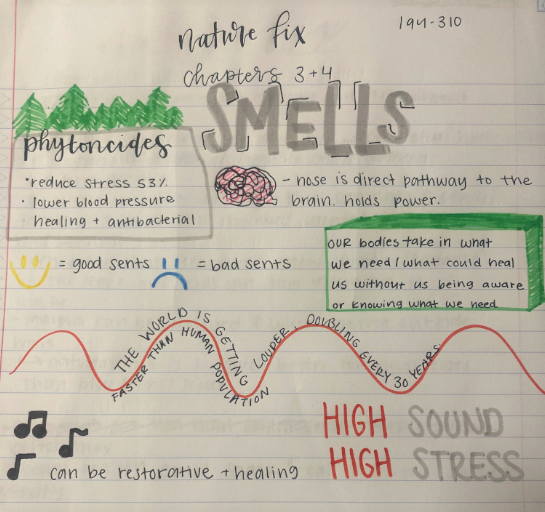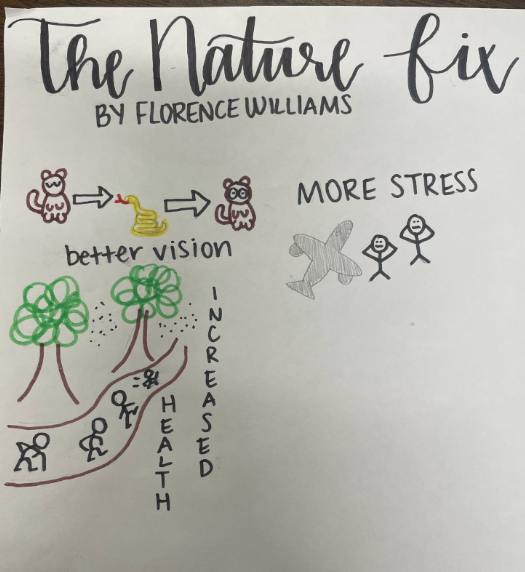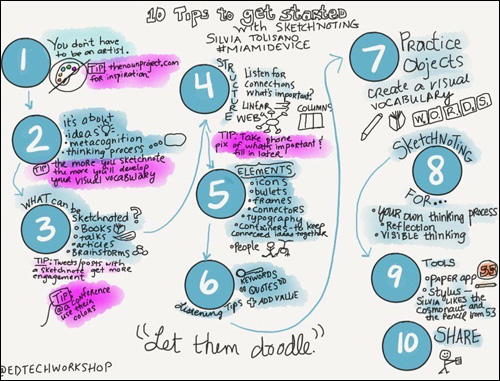

You may recall that, back in Base Camp training, we introduced the concept of "sketchnoting," or visual note taking, as part of the Instruction module. Sketchnoting can be a valuable means to visually convey information to students (not unlike infographics), or for students to demonstrate their own understanding of concepts either individually, or in groups.

"[Sketchnotes] are traditional written notes PLUS other elements like different forms of text and headlines, speech marks and other containers, arrows and dividers and of course, icons and drawings. They also make use of different systems to organise content in effective ways and not just moving from top to bottom of the page." - Sketchnote Classroom Blog
As you read these articles, keep in mind that sketchnoting is not just for those with an artistic bent! Although the only tools you need for sketchnoting are pen and paper, I often bring my iPad and Apple Pencil to conferences, Dialogue Days, and the like. Here are a few examples - notice the distinct lack of skilled artistic ability...
Melissa Parks, PhD | Faculty Focus | March 2, 2022
Drawing in college? It’s not quite that simple. Student engagement with course content is paramount to their understanding of course topics (Boekaerts, 2016). However, ins
While there are varied ways for students to take notes and interact with course content (Stacy, 2015), sketchnoting is an effective tool for enhancing interactions with course content and promoting engaging in-class discussions. Sketchnoting is a visual representation of content. It involves note-taking using words, pictures, shapes, and colors to capture essential points of course content (Baff, 2020; Erb, 2012). Sketchnoting is not about artistic ability. While that helps, the significance of the task is the connection students make with the content as they create their note. Focusing on the creation of a sketchnote can help summarize key ideas and parse out small, important details (Baff, 2020). An added layer of understanding can be developed as students share their notes with classmates and articulate important ideas the notes document. Sketchnoting is powerful because it allows students to document their connection to ideas in a manner that is meaningful to them.
On day two of class (although it is never too late to start), I ask students how many times they have used sketchnoting in other courses (most times it’s none). Acknowledging students have no prior knowledge, I provide a brief overview and explanation of the basic tenants of the concept and review this during the first few attempts with sketchnoting.
I complement my introduction with a brief tutorial video to clarify some of the uncertainty of the sketchnote. There are many videos available on YouTube and Google that range from quick two-minute blurbs to 30-minute detailed lessons. The tutorial video ends with a beautifully drawn sketchnote that leaves the class in silence. The finished product looks amazing! That presents the opportunity to display my personal teacher-made sketchnote sample. It cannot compare with the video sample, but it works to document the process of sketchnoting and captures the essence of a particular piece. Showing my sample and explaining my initial trepidation with the process reduces the students’ anxiety and sets the stage for a practice round.

For the first practice, I bring a collection of markers, crayons, and colored pencils to class and present a topic that is really simple and inconsequential—no course work, yet. Past practices have included videos on how cheese puffs are made and how astronauts prepare meals in space. The topics, for the first practice, are intentionally selected so all students have an equal entry point into the task. No grades are at stake, it’s just practice. After watching a quick video, or reading a short passage, students are given three to five minutes to sketch out one or two ideas that are new to them. For the initial practice, giving a quantifiable number of sketches you want students to complete helps them feel at ease. The quantifying of items on a note is not the normal expectation, it’s just an initial scaffolded experience to provide an opportunity for students to try sketching, discover which images readily come to mind, and determine how to apply those images, colors, and shapes to express ideas on their sketchnote.
After the initial practice, the first content-based learning experience is presented. Using a previously assigned reading task, students are directed to take five-minutes to create a sketchnote about the assigned reading.
In the beginning, students may be unsure of their artistic ability and may be fearful of critical judgment of their work. Establishing a culture of acceptance and support is key. For the first several sketchnoting experiences, I model different examples. I alternatively share a previously made (not fancy) sketchnote and create one on the board—terrible drawings included—to illustrate it’s about the process, not the artistic ability. This seems to be effective. When I asked students to send me samples of their in-progress sketch notes, anonymously, every single student complied.

While sketchnoting is interesting, helpful, and fun, it is time consuming (Valentina et al., 2020). Preparing students to understand the essence of sketchnoting, practicing, and eventually moving into course content takes time. That’s okay. It’s worth it. As students grow comfortable with the process of sharing sketchnotes both in small groups and with the whole class, it has generated multi-layered discussions with many contributors. My classroom discussions have become more robust using sketchnotes and students have demonstrated more engagement with the required readings. For me, sketchnoting is a keeper.
Melissa Parks, PhD, is an assistant professor of education in the Stetson University Department of Education.
Baff, D. 2020. “Using Sketchnotes in PhD Research and Academic Practice.” International
Journal of Management and Applied Research 7, no.3: 370-381.
Bell, M. A. 2015. “Embrace Your Inner Doodler! Join the Sketchnoting Revolution.”
Internet@Schools 22, no.2: 12–13.
Boekaerts,M. 2016. “Engagement as an Inherent Aspect of the Learning Process.”
Learning and Instruction 43: 76-83.
Erb, V. 2012. “How to Start Sketchnoting.” Bulletin of the American Society for Information
Science and Technology 39, no.1: 22–23.
Stacy, E. M., & Cain, J. 2015. “Note-taking and Handouts in The Digital Age.” American
journal of pharmaceutical education 79, no.7:107. https://doi.org/10.5688/ajpe797107
Valentina S., Bratash, E. I. Riekhakaynen, T. E., Petrova, 2020. “Creating and Processing
Sketchnotes: A Psycholinguistic Study.” Procedia Computer Science,176: 2930-2939.
Ditch That Textbook | January 1, 2020

Sketchnotes can capture your attention -- and capture an idea visually. They're a great way to communicate ideas. Here are 30 education sketchnotes to give you ideas and inspiration.
When I scroll Twitter for new teaching ideas, a good sketchnote can stop me in my tracks.
Maybe it's the color.
Maybe it's how busy the image is.
Maybe it's because there's a lot to unpack.
But often, I stop to unpack those ideas -- and they linger in my mind.
Sketchnoting (or visual notetaking) is the combination of images and text to create visually stimulating notes. There's all kinds of evidence for using them:
One talented sketchnoter -- Jen Giffen (Twitter: @VirtualGiff) -- has sketched presentations in all four years of the Ditch Summit.
If you're looking for ideas, Jen's sketchnotes will inspire and equip you.
Below is a Wakelet collection of Jen's sketchnotes from the Ditch That Textbook Digital Summit. You'll get ideas on a wide variety of topics, including technology, pedagogy, student relationships, equity, creativity and more. [On the Wakelet site,] click an image to see a larger version of it.

Here's one example, from a blended learning session:

Jennifer Giffen | VirtualGiff.com | Monday, 27 November 2017

This letter should not come as a surprise to anyone who knows me. I began my Sketchnoting journey in August 2016. I was reading a book and wanted to really capture and remember the ideas. I had heard a lot about sketchnoting and thought it might just be my answer. I tried it...and my first attempt was nothing to write home about.

But it did make me realise that I remembered more when I sketched. The next opportunity presented itself at a staff meeting when we were doing learning around Truth and Reconciliation. Normally at meetings, I do a lot of multitasking. I knew, given the importance of the topic, I needed to have a singular focus. So I sketched again. That night I went home and left my sketchnote on the kitchen table. When my husband came home, we engaged in a conversation about the staff meeting and the Indigenous Peoples of Canada. This would have never had happened if I had taken traditional notes. It was this moment that I really saw the power of sketchnoting.
Sketchnoting has since become my go to for taking notes. You can check out my Flickr account to see them all.
Enough about me...let's talk about what sketchnoting is and why should you do it. Check out this video:
The benefits are countless. To name a few, sketchnoting:

All in One Jackpot Resources!! (Research articles, collections, How & Why, Tools, Videos)
Inspiration for layouts and drawings
Practice Activities
Books
Blog Posts (including Slide Decks)
See Sketchnoting in action
Videos
Communities
Andrea Hernandez | CreativeEducator

Were you one of those students who always reached for a pen while listening to teachers or classmates? If so, you likely also remember being told to “stop doodling and pay attention!”
Thankfully, students today are far less likely to be chastised for doodling, and in many classrooms learners are being taught how to doodle purposefully as a way to record and internalize the salient points of a lesson.
This purposeful doodling is now referred to as sketchnoting, and it is now considered a useful technique to support information recall and build understanding.
In Sketchnotes 101, author Craighton Bermandescribes sketchnotes as “visual notes that are drawn in real time.” By drawing pictures of what they are hearing, students’ minds are engaging multiple modalities, often leading to increased retention of information. In Visual Note-Taking for Educators, author Wendy Pillars writes that sketchnoting or ’edusketching’ — can improve retention by up to 55%.
In this video, my fifth-grade student Samantha explains how doodling engages “all four ways learners learn: audio, visual, reading/writing and kinesthetic.”
Sam's TED ED Talk from MJGDS Classrooms on Vimeo.

I can imagine the protestations many of you have, so I will reassure you in advance: you do not need to be able to draw to introduce sketchnoting to your students! Sketchnoting isn’t about art. The important concepts, shares Silvia Tolisano, are “ideas, connections, thinking, about the process, visualizing and organizing your thinking.”
Although I don’t consider myself a natural artist, I was fascinated by the visual notes other people take and decided to learn to sketchnote. I also wanted to understand the process so I could help my 4th and 5th grade students add this technique to their toolkit of learning strategies.

Anxiety about my artistic shortcomings, coupled with a lack of personal experience with the process, left me wondering how to give my students the best possible experience, so I reached out to art teacher Shana Gutterman for ideas about implementing this style of note taking.
We began by having students watch Claudine Delfin’s Sketcho Frenzy: The Basics of Visual Note-taking. Shana then modeled the process by creating a sketchnote on the classroom whiteboard as I read aloud a chapter from a book my class is reading.
Despite being a skilled artist, Shana had never taken visual notes before. She was surprised at how natural it felt and found herself “thinking as I was drawing and retaining more information from the chapter than I would have if I just listened.”
Next, we distributed paper and colored pencils and asked the students to try sketchnoting. While some students preferred careful listening to sketchnoting, many loved the strategy and asked to be allowed to sketchnote during read-aloud time in class.
distributed paper and colored pencils and asked the students to try sketchnoting. While some students preferred careful listening to sketchnoting, many loved the strategy and asked to be allowed to sketchnote during read-aloud time in class.
Many of my students who continued to sketchnote elected to use Wixie and other digital tools available in my classroom. Students also used sketchnoting during listening activities such as Skype calls with experts and with students in other classrooms.
I was delighted to see that many of the students who struggled to some degree with recall or other areas of listening comprehension were drawn to sketchnoting. Their sketchnotes aided them with writing assignments and appeared to enhance their enjoyment of listening.
We live in a visual world. We all learn differently and demonstrate mastery in unique ways. Though many of us do not feel artistic, giving students opportunities to express their ideas visually using sketchnoting provides them a powerful strategy they can use to take ownership of their learning.

With a business card that reads "Passionate Educator", Andrea Hernandez has enjoyed (and is still enjoying) a long and winding career in education. With a Master's Degree Instructional Technology and coaching certificate, Andrea continues her learning journey by working with students and teachers, reflecting, blogging, tweeting (@edtechworkshop), collaborating, mistake-making, reading, creating and sharing. Her professional passions include student-centered learning environments, literacy and documenting growth using blogfolios.